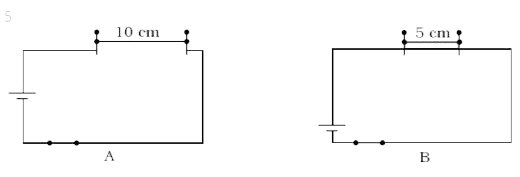Same mass of diamond and graphite (both being carbon) are burnt in oxygen. Will the heat produced be same or different? Why?
Give reasons for the following:
To determine whether the heat produced from burning the same mass of diamond and graphite in oxygen will be the same or different, we can analyze the combustion reactions of both forms of carbon.
1. Identify the Combustion Reactions:
- The combustion of diamond (C_diamond) in oxygen can be represented as:
Cdiamond+O2→CO2
- The combustion of graphite (C_graphite) in oxygen can be represented as:
Cgraphite+O2→CO2
2. Define Enthalpy Changes:
- Let the enthalpy change (heat released) for the combustion of diamond be ΔH1 and for graphite be ΔH2.
- We can denote the heat released from the combustion of diamond as −x (where x is a positive value) and from graphite as −y.
3. Standard Form of Carbon:
- Graphite is considered the standard form of carbon. This means that its enthalpy of formation is defined as zero, while diamond is less stable compared to graphite.
4. Heat of Formation:
- When graphite is converted to diamond, it requires energy, which can be represented as:
Cgraphite→CdiamondΔH=+2 kJ
- Therefore, the enthalpy change for the combustion of diamond can be related to that of graphite:
ΔH1=ΔH2+2 kJ
5. Comparison of Heat Released:
- Since ΔH1 (heat released from diamond) is equal to ΔH2+2 kJ, it indicates that the heat released from burning diamond is greater than that from burning graphite.
- Thus, when burning the same mass of diamond and graphite, the heat produced will be different.
6. Conclusion:
- The heat produced from the combustion of diamond will be greater than that produced from the combustion of graphite due to the stability of graphite as the standard form of carbon.
Final Answer:
The heat produced from burning the same mass of diamond and graphite in oxygen will be different. The combustion of diamond releases more heat compared to graphite because diamond is less stable than graphite, leading to a higher enthalpy change during combustion.
- The combustion of diamond (C_diamond) in oxygen can be represented as:
Cdiamond+O2→CO2
- The combustion of graphite (C_graphite) in oxygen can be represented as:
Cgraphite+O2→CO2
- Let the enthalpy change (heat released) for the combustion of diamond be ΔH1 and for graphite be ΔH2.
- We can denote the heat released from the combustion of diamond as −x (where x is a positive value) and from graphite as −y.
- Graphite is considered the standard form of carbon. This means that its enthalpy of formation is defined as zero, while diamond is less stable compared to graphite.
- When graphite is converted to diamond, it requires energy, which can be represented as:
Cgraphite→CdiamondΔH=+2 kJ
- Therefore, the enthalpy change for the combustion of diamond can be related to that of graphite:
ΔH1=ΔH2+2 kJ
- Since ΔH1 (heat released from diamond) is equal to ΔH2+2 kJ, it indicates that the heat released from burning diamond is greater than that from burning graphite.
- Thus, when burning the same mass of diamond and graphite, the heat produced will be different.
- The heat produced from the combustion of diamond will be greater than that produced from the combustion of graphite due to the stability of graphite as the standard form of carbon.
The heat produced from burning the same mass of diamond and graphite in oxygen will be different. The combustion of diamond releases more heat compared to graphite because diamond is less stable than graphite, leading to a higher enthalpy change during combustion.
Similar Questions
Same mass of diamond and graphite (both being carbon) are burnt in oxygen. Will the heat produced be same or different? Why?
Give reasons for the following:View SolutionOne kilogram of graphite is burnt in a closed vessel.The same amount of graphite is burnt in an open vessel.Will the heat evolved in two cases be same or different?
View Solution
Knowledge Check
- Question 1 - Select One
The mass of graphite which should be burnt completely with 9.6 gm oxygen to produce CO and CO2 gases in 4 :1 mole-ratio is :
A12.0 gmB7.2 gmC6.0 gmD4.8 gm
Why do diamond and graphite, the two allotropic forms of carbon evolve different amounts of heats on combustion?
View SolutionOne kilogram of graphite is burnt in a closed vessel.The same amount of graphite is burnt in an open vessel.Will the heat evolved in two cases be same or different?
View SolutionTwo organ pipes of same length, open at both ends produce sound of different pitch, if their radii are different. Why?
View SolutionDo all the photons of differents colour have the same mass? If not, why?
View SolutionPaheli took a wire of length 10 cm. Boojho took a wire of 5 cm of the same material and thickness. Both of them connected the wires as shown in the circuit given in Figure 14.4. The current flowing in both the circuits is the same.
(i) Will the heat produced in both the cases be equal? Explain.
(ii) Will the heat produced be the same if the wires taken by them are of equal lengths but of different thickness? Explain.
 View Solution
View SolutionA deutron and a proton are accelerated by the cyclotron. Can both be accelerated with the same oscillator frequency? Give reason to justify your answer.
View SolutionA deutron and a proton are accelerated by the cyclotron. Can both be accelerated with the same oscillator frequency? Give reason to justify your answer.
View Solution

